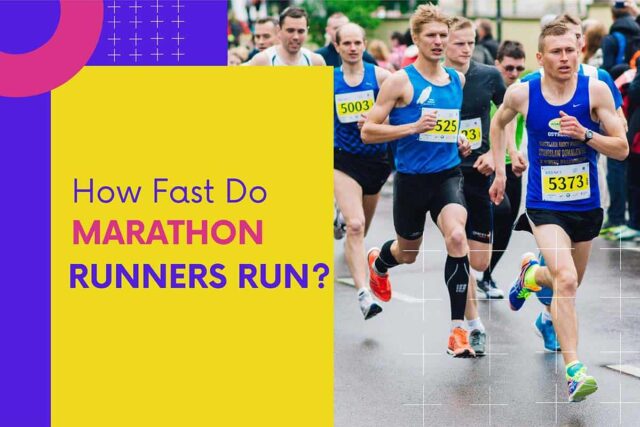These days marathons are very popular. A marathon is typically a long-distance race. A marathon usually is run on roads. A considerable amount of people can participate in a marathon.
The first-ever marathon to be run was in 490 B.C. Pheidippides, who was a Greek soldier run from a battle near the town of Marathon to Athens. Legend states that Pheidippides run 25 miles, which was quite impressive.
Eliud Kipchoge currently holds the world record for the marathon race. Kipchoge ran the Berlin marathon with a time of 2:01:39. The marathon was on 16th September 2018.
The world record for the fastest female marathoner is also a Kenyan. Brigid Kosgei is the record holder. She did an impressive time of 2; 14;04 in 2019.
These average speeds are easy for an ordinary person to attain. Let’s be honest; your average running pace can beat any world record.
So, how fast do marathon runners run?
The average speed for a male marathon runner is 6.43 minutes per kilometer. While that of a female marathon runner is 7.26 minutes per kilometer. This is according to data provided by Run Repeat.
They don’t run that fast. It’s more about the preservation of energy and having stamina. A decent steady pace wins a marathon.
Marathon Runners’ Health
The prime of professional marathon runners’ carriers is typically in their 20s and 30s. This is the age where physical fitness tends to peak in for almost everyone.
These marathon runners tend to work out a lot. Marathon runners don’t require muscles but instead workout to burn calories. The exercises marathon runners do help them sustain endurance.
The intense workout makes marathon runners look skinny and older than they are. They have saggy skin due to the impact and bouncing while they run.
Marathon running reduces your risk of getting a cardiac arrest or other heart-related problems. But why do some marathon runners collapse and die? The answer is lactic acid build-up in the body.
Lactic acid builds up in the body as the marathon runners run. The lactic acid in the blood causes exhaustion, abnormal heart rhythms, and also heart strokes. The build-up in lactic acid causes the marathon runners to collapse near the finish line.
Running long marathons can lead to a drop in blood pressure. The decrease in blood pressure causes dehydration and this, in turn, leads to lightheadedness. The dizziness causes the marathon runners to collapse close to the finish line.
Even though running marathons can be classed as ‘pushing yourself too hard,’ deaths of marathon runners during a race are rare. There are pros and cons of being a marathon runner.
Running marathons gives a boost to your immunity. Your body is forced to work harder to increase your breathing rate. Blood circulation is also increased. This helps your body remove carbon dioxide processed.
Marathon runners publicly relieving themselves
The official distance of a marathon is 42.195 kilometers. Relieving themselves in public is typically a fact about a marathon runner’s life.
Both female and marathon runners have been known to pee or poop publicly or themselves. This is not as easy as telling them to wait until they poop or pee to go running.
Running, like any exercise, helps in preventing constipation. But what happens to the marathon runners? Running increases gastric motility in human beings; this is called runner’s trot or runner’s diarrhea.
Gastric motility causes abdominal cramping and diarrhea in marathon runners. The passing of materials through the gastrointestinal tract is affected.
The stool is loosened, and the marathon runner has no control of when and how often they have to relieve themselves.
There are usually portal potties at the start line and also along the way in some marathon races. Relieving yourself before running a marathon is ideal.
How many marathons are held annually?
Every year, there are more than 800 marathons organized. They are in many different locations in the world. Most are organized by the Association of International Marathon and Distance Races (AIMS).
The Biennial World Marathon Majors organize others. The marathons of Berlin, Boston, London, Chicago, New York City, and London are under this organization.
This series gives an award of $500,000 to the winners. There are many other smaller marathons organized for different purposes.
For the disabled, there is a wheelchair division. The 1st wheelchair marathon was held in Toledo, Ohio, in 1974. These marathoners record better time than runners.
This is a true show of the saying; disability is not inability. The fastest recorded an astounding 1:20:13 in Oita Japan. Marathons have involved everyone in society, and they are very popular.
Are marathons involved in charities?
Marathons are sometimes used as charity events. Some charities use marathons to raise money. Some of the money for tickets is used for charity.
In other events, the marathoners pay for slots. Some of the money they pay is then transferred to charity. Some charities start their charities. All the money they make is then used in the charity.
Considering how popular marathons are, a lot of money can be raised. Money gets accumulated from sponsorships and entry fees. This presents a chance for runners to use their talent for good.
How many types of marathons are there?
There are several types of marathons. Depending on the host and other factors, races of different kinds are held.
10 Km marathon
This is the shortest of all marathons. It is a 6.21-mile course. This race is built to help track your progress in a race situation.
It would test your speed, fitness, and stamina. This would be a great way to train for marathons.
Half marathon
As suggested by the name, this is half the marathon distance. It is a 21.1 km race. This is mostly for beginners that haven’t learned how to balance their stamina well.
It is a kind of preparation stage. It prepares marathoners both physically and mentally.
Marathon
This is the average 42.2 Km race. It is the most common race. Countless runners take part in this race.
It is mostly for experienced athletes that have gone through rigorous training.
Ultra-marathon
This is the toughest of all the marathons. It is any marathon that is longer than 42.2 Km long.
The level of fitness, skill, and resilience needed is inhuman. This is a category for the best athletes. The sheer amount of training you need to get here can scare anyone off.
There are not so many Ultra-marathons due to this demanding nature. The participants are fewer compared to marathons.
FAQs
Has Usain Bolt run a marathon?
Usain Bolt has never run a marathon. The Jamaican sprinter is the world record holder of a 100-meter dash at 9.58 seconds.
For a sprinter like Bolt, completing a marathon can be difficult. The muscle structure of a sprinter is very different from that of a marathon runner.
Ex-smokers, how did your running improve after quitting?
Running after you quit smoking improves immensely. There is a greater oxygen supply to the muscles, and running also improves blood supply.
Smoking hurts your performance as a runner. The negative impacts are because of the high carbon monoxide content in your blood.
What is the average pace for a marathon runner?
The average speed for a female marathon runner is 7.26 kilometers per hour. That of a male runner is 6.43 kilometers per hour. You would need to maintain that pace for about 6 hours.
This is what makes marathons so tough on the athletes. Many have left in the middle of races. Others passed out due to dehydration and or exhaustion.
What is the average finish time for a marathon runner?
The average finish time for a marathon is about 6.2 hours. Running for six straight hours without rest is quite impressive.
The best recorded time was by Kenya’s Eliud Kipchoge Keino. He finished the Berlin Marathon in a record 2:01:39.
What Kind of sole is best for running shoes?
Thick-soled shoes are the best shoes for running. Thick soles offer more comfort as you run. Running shoes should be light in weight but have thick cushioning.
This all comes down to comfort. You will be running for a long time. Therefore, the shoe you wear should be comfortable to ensure that you don’t get uncomfortable or have blisters.
Is there a specific design for shoes for running?
Yes, some shoes are specifically designed for running. They are well cushioned and designed to be light. They have studs to help with grip.
The soles of running shoes should be thicker around the heel and toe area. They should keep the foot and ankle secure to prevent twisting or sprains.
Conclusion
Athletics is one of the most popular sporting events on the planet. When talking about athletics, marathons cannot be left out. These days there have been a lot of marathons and impressive new records.
As younger athletes come up, fans expect even better records as marathons get more and more recognized. Inevitably more athletes will be drawn to participate. And we will discover that marathon runners will always run faster than imagined and break new world records.
You May Like These Articles As Well:














